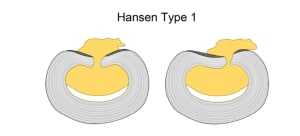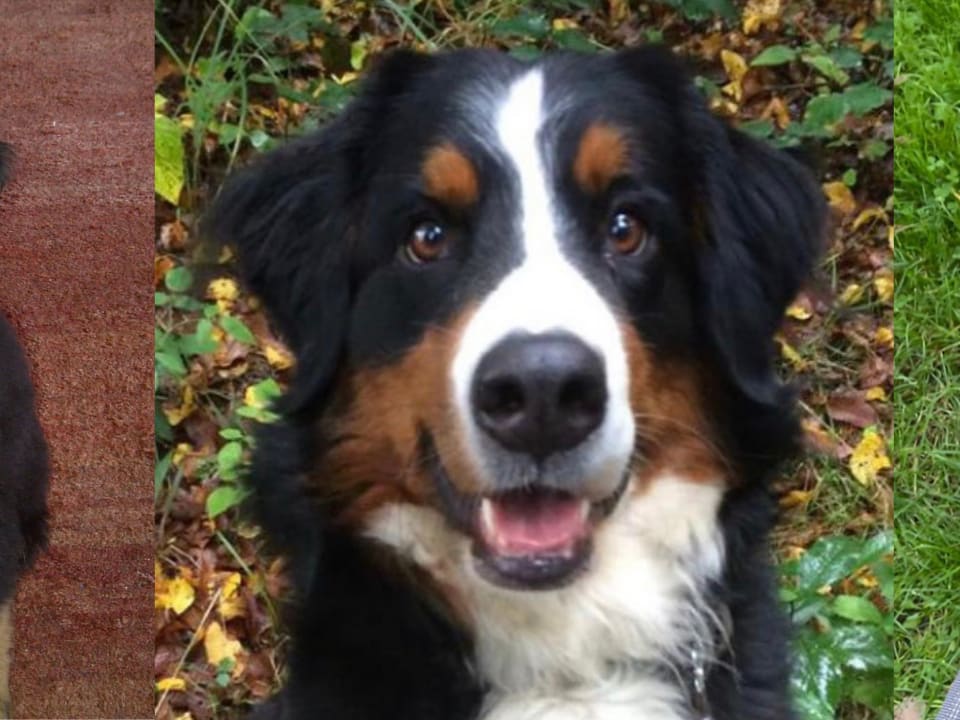Genetic health screening with Embark includes testing for the variant associated with Type I Intervertebral Disc Disease (IVDD), often referred to as a slipped or herniated disc. Type I IVDD is most common in “long and low” breeds like Dachshunds, Corgis, and Basset Hounds. However, many dogs of all shapes and sizes can be at increased risk for developing a slipped disc.
All dogs who undergo health testing with Embark will receive results for this test in their profile. Armed with that knowledge, dog owners can take steps to reduce the risk of an IVDD incident.
What is IVDD in dogs?
Type I IVDD occurs when the soft center of the spinal disc—also known as the nucleus pulposus—is squeezed out into the spinal canal, compressing the spinal cord. IVDD is a degenerative condition that can cause back pain and limit mobility. Affected dogs may show a sudden onset of hind leg weakness, paw dragging, and/or back pain.
Treatment ranges from conservative medical management and rest to surgery, in which case the extruded disc material and some parts of the vertebrae are removed. Physical therapy is also recommended to help your dog get back up to speed.

Hansen Type I IVDD involves extrusion of the nucleus pulposus, colored yellow in this diagram, which then compresses the spinal cord. Image from Smolders et al.
Is Type I IVDD genetic?
In 2017, researchers at the University of California, Davis discovered a genetic variant that increases the risk for a slipped disc across many breeds. Dogs with two copies of the variant typically appear to have shorter legs and a longer body. Note that another variant that causes a similar conformation, called chondrodysplasia (CDPA), was discovered many years ago. However, the CDDY variant has a bit more to it.
The research team started with Nova Scotia Duck Tolling Retrievers. They had observed that some Tollers had shorter legs than others and that these shorter-legged dogs were much more likely to develop Type I IVDD. When they identified a variant predictive of CDDY phenotype, they also found that the dogs diagnosed Type I IVDD had more that 50x greater odds of having the variant compared to dogs who were Type IVDD free (Odds Ratio = 51.23).
The study did not evaluate the relative risk in mixed-breed dogs, but given that Type I IVDD is diagnosed regularly in mixed breeds, it’s likely that the variant plays a role in at least some mixed-breed cases. Although there’s more to be discovered about the risk factor for mixed breeds, knowing about this potential genetic risk gives you and your veterinarian a chance to discuss preventative care and monitoring.
How Embark tests for Type I IVDD in dogs
We’re always on the lookout for new genetic discoveries that can be incorporated into our testing panel and have actionable results for owners, breeders, and veterinarians. There are different ways we do this, and in the case of IVDD, it’s through a linkage test. DNA sequences that are close together on a chromosome tend to be inherited together, so we’re able to infer the presence or absence of a variant of interest by examining the genetic variation surrounding it. Because linkage tests don’t directly look at a variant of interest, they may not be perfectly predictive of your dog’s true genotype.
What to do if your dog tests positive for the IVDD variant
Keep in mind that a genetic risk is not a diagnosis. Just like in humans, the risk for a dog experiencing a herniated disc is affected by several factors, including other genes, diet, exercise, and lifestyle. While this variant result may inform risk, it’s not a guarantee of disease, and there are lots of things you can do that may help your dog avoid a slipped disc altogether.
First on the list of preventative tips is to keep your dog physically fit and in good body condition. This is associated with reduced IVDD risk, at least in Dachshunds, one of the breeds at higher risk for the condition. And if your pup is regularly jumping on and off of the sofa or bed, a set of dog-friendly steps can help.
Signs of Type I IVDD in dogs
If your dog does experience a slipped disc, they’ll have a better chance for recovery the sooner they’re treated, so owners with at-risk dogs should be on the lookout for any signs of back pain or spinal cord compression. Take note if your dog is less willing to jump into bed at night, is reluctant to run during play, or has trouble posturing to poop or pee. Your dog’s walking cadence can also provide clues. Are they sliding or scuffing their paws to walk, instead of picking them up and setting them down? Are the nails on one paw getting more worn down than the others? If so, a trip to the vet may be in order.
For dogs who have an IVDD diagnosis, or known genetic risk for Type I IVDD, there are several mobility support tools that can help reduce unnecessary strain on their backs and limbs.
And tell us about it, too! If your dog has been diagnosed with IVDD, please let us know by filling out your Medical History Assessment or emailing us at [email protected]. This information will help us better understand genetic risk for IVDD and could potentially help other dogs at risk for the condition in the future.
Learn more about ongoing research at Embark, and find out how you can contribute to health discoveries that can benefit all dogs.














